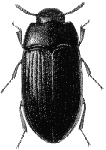Lesser Mealworm
Pest Management Fact Sheet #5028
 James F. Dill, Pest Management Specialist
James F. Dill, Pest Management Specialist
Clay A. Kirby, Insect Diagnostician
For information about UMaine Extension programs and resources, visit extension.umaine.edu.
Find more of our publications and books at extension.umaine.edu/publications/.
Introduction
The lesser mealworm, Alphitobius diaperinus, may be found in any area where there is damp or moldy manure, litter, grain, milled products, or spoiling food. These conditions are usually found wherever there is livestock or poultry. The larvae and adults will also feed on dead animals. High populations of the beetles may become a nuisance in farms and surrounding communities.
Description & Biology
Adult lesser mealworms are black or dark reddish brown and are about 1/4″ long. They can move quite rapidly. The 200 to 400 eggs laid by each female are usually found in crevices of grain. The yellowish brown larvae are worm-like and are about 3/8″ long.
While feeding and growing, the larvae will molt 7 to 11 times in the approximately 50 days it takes them to become a pupa. The pupal stage will last an average of 7 days, for a total of 60 days from egg to adult. The newly emerged female will start egg laying in about 11 days. The lesser mealworm will complete one whole cycle, egg to egg, in approximately 70 days during generally favorable temperatures and diets. The larvae and pupae are rarely seen because they hide under boards, in litter, etc. The adults are nocturnal. Few commercial poultry operations in Maine are free of these beetles. Because the creatures live in litter, it is generally believed that they cause no damage or problems. However, lesser mealworms are known to attack the digestive tracts of sickly birds. Also, mealworms are aggressive, destroying the eggs and larvae of beneficials such as predaceous mites and pseudoscorpions, that may also be attracted by the litter. Mealworms are also credited with destroying the eggs and larvae of nuisance insects such as fly eggs and maggots. In some states, the insect is introduced into new chicken houses or freshly cleaned houses to aid in fly control. But in many cases, high populations of beetles have failed to reduce or control fly populations in Maine.
One concern regarding the use of mealworms to control indoor flies is that some larvae will migrate to walls, where they may chew holes in foam fiberglass insulation and wood to create spaces for pupation. However, most of the pupae are found in manure. Of greater concern is the dispersal of beetles when litter is piled or spread on fields. Some areas have had severe problems as a result, with hundreds of these beetles invading nearby homes.
Because lesser mealworms are widely distributed and their food and habitats are found in many rural areas, it seems unlikely that a farm could ever be kept entirely free of the insects. Populations must be kept as low as possible, because lesser mealworms can spread certain poultry diseases and damage insulation.
Management
When areas around homes are infested with lesser mealworms, reduce the light visible from the house proper and turn on a bright light elsewhere to draw the mealworms away from the house. An insecticide labeled for perimeter treatment (e.g. permethrin) around the outside of a home can be used to kill beetles hiding in grass, under shrubbery, siding, porches, etc., during the day. A blacklight electrocuting unit placed in an area away from the house may also help.
When Using Pesticides
ALWAYS FOLLOW LABEL DIRECTIONS!
Pest Management Unit
Cooperative Extension Diagnostic and Research Laboratory
17 Godfrey Drive, Orono, ME 04473
1.800.287.0279 (in Maine)
Information in this publication is provided purely for educational purposes. No responsibility is assumed for any problems associated with the use of products or services mentioned. No endorsement of products or companies is intended, nor is criticism of unnamed products or companies implied.
© 2016, 2018, 2020 | Reviewed & Revised: 2023
Call 800.287.0274 (in Maine), or 207.581.3188, for information on publications and program offerings from University of Maine Cooperative Extension, or visit extension.umaine.edu.
In complying with the letter and spirit of applicable laws and pursuing its own goals of diversity, the University of Maine System does not discriminate on the grounds of race, color, religion, sex, sexual orientation, transgender status, gender, gender identity or expression, ethnicity, national origin, citizenship status, familial status, ancestry, age, disability physical or mental, genetic information, or veterans or military status in employment, education, and all other programs and activities. The University provides reasonable accommodations to qualified individuals with disabilities upon request. The following person has been designated to handle inquiries regarding non-discrimination policies: Director of Equal Opportunity, 101 Boudreau Hall, University of Maine, Orono, ME 04469-5754, 207.581.1226, TTY 711 (Maine Relay System).

